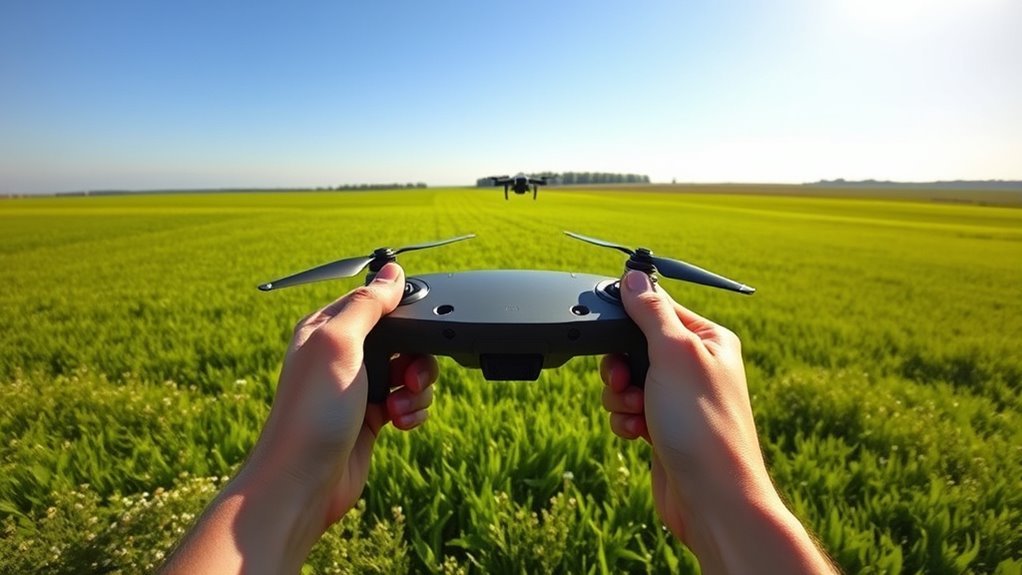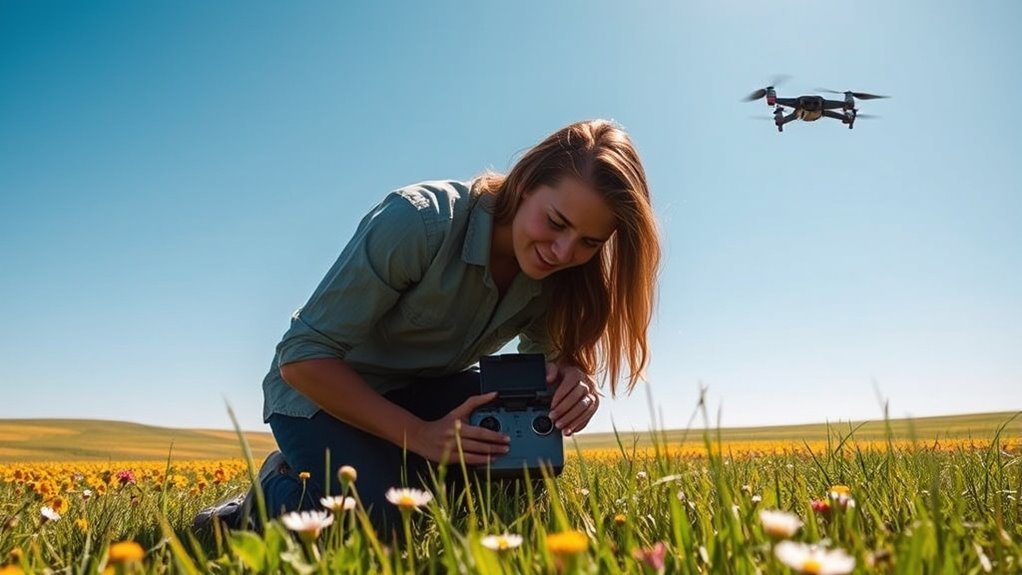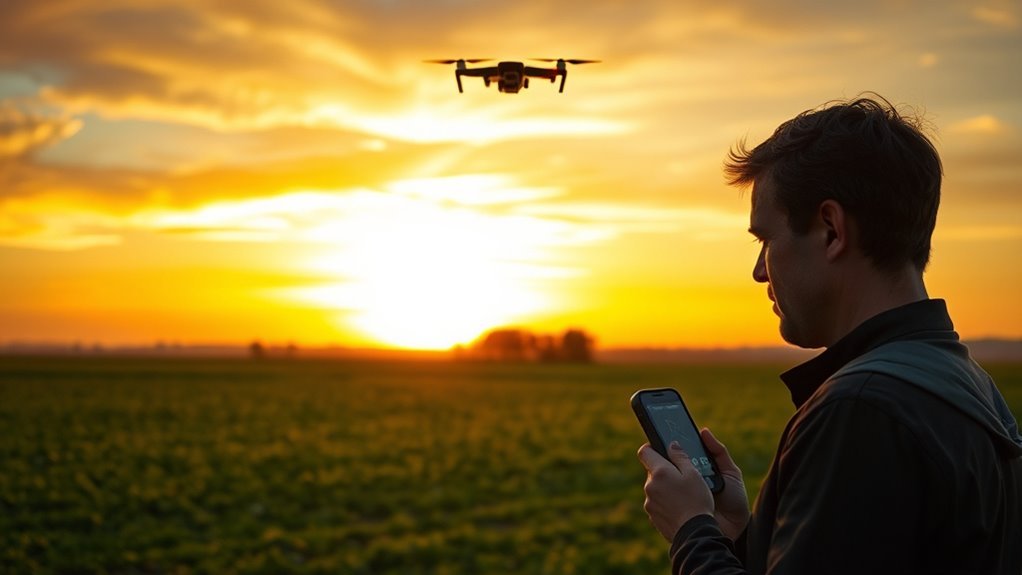If you’ve lost your drone, start by using its built-in GPS features to track its last known location. Check for strong satellite signals and guarantee you’re familiar with the associated mobile apps for real-time updates. Search the area systematically, focusing on potential obstacles that might have interrupted its path. Utilize community resources if needed and remain aware of any visual or sound signals for better visibility. There’s more you can do to prevent future losses and enhance recovery strategies.
Understanding Drone Technology and Its Limitations

Although drones have revolutionized various fields, from photography to surveying, understanding their technology and limitations is essential for effective operation. Familiarize yourself with the primary drone components, including the frame, motors, battery, and navigation systems. Each part plays a significant role in the drone’s performance and reliability. You should also be aware of potential signal interference, which can disrupt communication between your drone and its controller. Factors like physical obstacles, electromagnetic fields, and other wireless devices can affect your drone’s functionality. Knowing how to mitigate these issues is important for maintaining control. By grasping these concepts, you’ll be better equipped to navigate the skies and minimize the risk of losing your drone in the first place. Utilizing GPS tracking features can significantly enhance your ability to locate a lost drone. Understanding the range capabilities of your drone, whether through LTE or radio signals, can also help you avoid areas where signal loss might occur.
Preparing for Your Drone Flight

Before you take to the skies, it’s essential to methodically prepare for your drone flight to guarantee a smooth and safe operation. Start with a thorough pre-flight inspection. Use a drone checklist to verify you don’t overlook any critical elements. Here’s a handy table to guide you:
| Task | Status |
|---|---|
| Battery charged | ✅ |
| Firmware updated | ✅ |
| Propellers secured | ✅ |
| GPS signal acquired | ✅ |
Checking each item will help you identify any issues before launch. Also, familiarize yourself with your drone’s controls and settings. Keep in mind that understanding your drone’s enhanced safety features can significantly reduce the risk of accidents. Remember to check for local regulations to ensure compliance with the law. The freedom of flight awaits, but preparation is key to making it enjoyable and safe.
Utilizing Built-In GPS Features

Once you’re airborne and have completed your pre-flight checks, the built-in GPS features of your drone can considerably enhance your flying experience and safety. First, verify your GPS accuracy is ideal by allowing the drone to acquire satellites before takeoff. This helps maintain a solid connection, reducing the risk of signal loss as you fly. If you notice the signal weakening, adjust your altitude or direction to regain a stronger connection. Always keep an eye on your drone’s GPS status; it’ll give you real-time updates on its location. Should you lose sight of your drone, the GPS coordinates can guide you back to it, making recovery much easier. Embrace these features for a more secure and enjoyable flight.
Leveraging Mobile Apps for Tracking
Many drone enthusiasts find that leveraging mobile apps for tracking can markedly improve their chances of locating a lost drone. These apps often come packed with useful mobile tracking features that can guide you back to your beloved device.
- Feel the thrill of reclaiming your freedom in the skies.
- Experience the relief of knowing you’re not alone in this journey.
- Relish the satisfaction of mastering technology to reconnect with your drone. Additionally, look for apps that offer real-time data processing to enhance your ability to track and locate your device quickly.
When choosing an app, look for features such as real-time location updates, geofencing alerts, and remote control access. These can enhance your search and guarantee you’re equipped to handle any situation. With the right mobile tracking app, you’ll be well on your way to finding your lost drone. Additionally, consider apps that utilize real-time tracking to provide instant visibility of your drone’s location, ensuring you have the most accurate information during your search.
Employing a Drone Recovery System
While losing a drone can be frustrating, employing a drone recovery system can greatly increase your chances of retrieving it. Start by selecting a reliable recovery system that suits your drone model. Many systems utilize GPS tracking, allowing you to pinpoint your drone’s location easily. Make sure to install the recovery device before flying; this proactive approach is essential. Additionally, consider systems that offer real-time alerts, notifying you if your drone goes beyond a certain range. Once you activate the recovery system, follow the provided instructions to track and locate your drone. Remember, the quicker you act, the better your chances for successful drone recovery. Investing in these systems not only enhances your flying experience but empowers your adventurous spirit. Additionally, ensure that you develop a pre-flight checklist to avoid potential issues that may lead to losing your drone. Implementing a recovery system with advanced data encryption can further secure your drone’s operational integrity.
Searching the Last Known Location
As you begin searching for your lost drone, it’s essential to head to the last known location where it was operational. This spot serves as the cornerstone of your search strategy, guiding your efforts and maximizing your chances of recovery. Start by retracing your drone’s flight path, and keep an eye out for any unusual objects that might stand out.
- The thrill of freedom you felt while flying
- The anticipation of that perfect aerial shot
- The disappointment of losing your device
Stay calm and methodical. Check the area thoroughly, looking in trees, bushes, or other potential hiding spots. Remember, each minute counts, and your persistence could lead you back to the freedom of flying again.
Enlisting Help From the Community
Reaching out to your local community can greatly enhance your chances of finding your lost drone. Utilizing community support through local forums can be invaluable. Post your situation in these spaces, and provide details like the last known location, drone type, and any unique identifiers.
| Action | Benefit | Platform |
|---|---|---|
| Post on Forums | Engage with local enthusiasts | Facebook, Reddit |
| Organize a Search | Mobilize volunteers | Community groups |
| Share on Social Media | Broaden reach | Instagram, Twitter |
Preventive Measures for Future Flights
To prevent the loss of your drone in the future, it is crucial to implement a series of proactive measures before each flight. Start by establishing a thorough pre-flight checklist. This checklist should include:
- Checking GPS signal strength to guarantee reliable navigation.
- Performing battery management to verify your drone has enough power for the entire flight.
- Inspecting propellers and other components for any signs of wear or damage.
Additionally, incorporating real-time monitoring can help ensure that your drone maintains stability and performance throughout its flight, reducing the risk of losing it in challenging conditions. Effective flight stability management is essential for operations in chaotic environments, enhancing your drone’s reliability during missions.
Frequently Asked Questions
Can I Track My Drone Without GPS Enabled?
While it’s tricky without GPS, you can still explore drone tracking through sound and visual cues. Employ recovery techniques like retracing your flight path or asking nearby enthusiasts for help. Don’t lose hope; it’s still recoverable!
What Should I Do if My Drone Crashes in Water?
If your drone crashes in water, act fast. Prioritize water recovery by retrieving it immediately. Dry it thoroughly, disassemble for rehabilitation, and clean components. Consult experts for repair, ensuring your drone’s ready for future adventures.
How Can Weather Conditions Affect Drone Recovery Efforts?
Weather can be a double-edged sword for recovery. Wind impacts your search, making control difficult, while rain interference can obscure visibility. Stay aware of conditions, adjusting your approach to enhance your chances of retrieval.
Are There Legal Restrictions for Searching in Certain Areas?
When searching for your drone, you should check local drone recovery laws. Certain areas might have search area restrictions, especially near private property or sensitive locations. Always make certain you’re compliant to avoid legal issues.
What Should I Do if I Spot My Drone but Can’t Reach It?
If you spot your drone but can’t reach it, consider using drone retrieval techniques like extending a pole or employing a ladder. Always prioritize safe recovery methods to avoid potential accidents or damage during retrieval.

